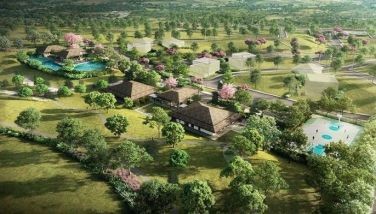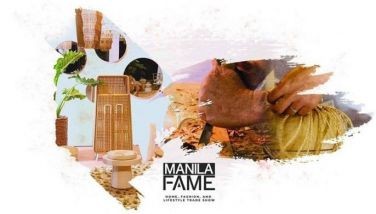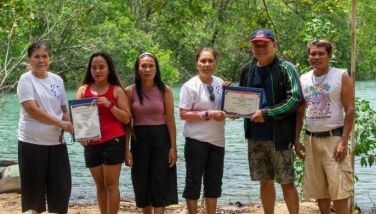Former UP prof receives posthumous NAST award
June 29, 2006 | 12:00am
A former University of the Philippines’ professor recently received a posthumous award from the National Academy of Science and Technology (NAST) for his dream of restoring the life of lahar-stricken areas in Pampanga following the June 1991 eruption of Mt. Pinatubo.
Dr. Wilfredo Barraquio, a former professor of the UP Diliman’s Institute of Biology, was conferred the Hugh Greenwood Environmental Award for his contributions to environmental research, specifically on using microbes to clean and restore damaged environments.
The Department of Science and Technology said one of Barraquio’s fondest dreams was to spray bacteria and bacteria-coated legumes from a helicopter to bring lahar-covered countryside back to life again.
"It is quite sad that this award had to be given to Willy posthumously," Science and Technology Secretary Estrella Alabastro said.
"But it makes us happy that there are now more research institutions and scientists like Willy who are doing environmental studies," she said.
Barraquio died early this year due to heart disease.
Now on its sixth year, the NAST put up the Hugh Greenwood Environment Award to recognize outstanding research works that contribute to environmental protection and conservation.
The grand prizewinner received $1,000 courtesy of Dr. Hugh Greenwood, founder of the United Kingdom-based Children’s Research Fund.
"The DOST is also giving a P1-million research grant to the awardees as a way of encouraging scientists to continue and persevere in their scientific activities despite limited budget and other inadequacies," Alabastro said.
Barraquio’s wife, Virginia, a scientist based in UP Los Baños Dairy Training and Research Institute, was the one who presented his late husband’s paper.
The first study done by Barraquio’s team was to use bacteria in determining the toxicity of a synthetic dye called Congo Red, which was widely used in handmade paper manufacturing.
The research team said a large amount of the dye was found in some canals and rivers near a paper factory in Biñan, Laguna.
Using the bacteria, the team determined the dye’s toxic levels in water samples taken from the site.
The study showed that the liquid samples’ color turned clear as the bacteria devoured the toxic elements.
The microorganisms are thus called "decolorizing bacteria." Decolorized samples also showed that the bacteria are able to reduce the dye’s severe toxicity.
The team observed that the plant growth-promoting nutrients formed in the water as the bacteria consumed the toxins.
Meanwhile, a second study detailed the microorganisms’ role in turning the lahar-devastated areas around Mt. Pinatubo productive again.
The DOST said Barraquio’s study found out that these microorganisms, called arbuscular mycorrhizal fungi, survive in wild sugarcanes growing in the Pasig-Potrero River in Barangay Maniag-Pasig in Pampanga.
The study showed that despite the dry, lahar-strewn environment, these fungi thrive in wild sugarcane, also supporting the growth of legumes.
Barraquio concluded in his study that reviving vegetation around Mt. Pinatubo could be spurred by planting sugarcane on a wider scale to encourage the growth and proliferation of the fungi.
Dr. Wilfredo Barraquio, a former professor of the UP Diliman’s Institute of Biology, was conferred the Hugh Greenwood Environmental Award for his contributions to environmental research, specifically on using microbes to clean and restore damaged environments.
The Department of Science and Technology said one of Barraquio’s fondest dreams was to spray bacteria and bacteria-coated legumes from a helicopter to bring lahar-covered countryside back to life again.
"It is quite sad that this award had to be given to Willy posthumously," Science and Technology Secretary Estrella Alabastro said.
"But it makes us happy that there are now more research institutions and scientists like Willy who are doing environmental studies," she said.
Barraquio died early this year due to heart disease.
Now on its sixth year, the NAST put up the Hugh Greenwood Environment Award to recognize outstanding research works that contribute to environmental protection and conservation.
The grand prizewinner received $1,000 courtesy of Dr. Hugh Greenwood, founder of the United Kingdom-based Children’s Research Fund.
"The DOST is also giving a P1-million research grant to the awardees as a way of encouraging scientists to continue and persevere in their scientific activities despite limited budget and other inadequacies," Alabastro said.
Barraquio’s wife, Virginia, a scientist based in UP Los Baños Dairy Training and Research Institute, was the one who presented his late husband’s paper.
The first study done by Barraquio’s team was to use bacteria in determining the toxicity of a synthetic dye called Congo Red, which was widely used in handmade paper manufacturing.
The research team said a large amount of the dye was found in some canals and rivers near a paper factory in Biñan, Laguna.
Using the bacteria, the team determined the dye’s toxic levels in water samples taken from the site.
The study showed that the liquid samples’ color turned clear as the bacteria devoured the toxic elements.
The microorganisms are thus called "decolorizing bacteria." Decolorized samples also showed that the bacteria are able to reduce the dye’s severe toxicity.
The team observed that the plant growth-promoting nutrients formed in the water as the bacteria consumed the toxins.
Meanwhile, a second study detailed the microorganisms’ role in turning the lahar-devastated areas around Mt. Pinatubo productive again.
The DOST said Barraquio’s study found out that these microorganisms, called arbuscular mycorrhizal fungi, survive in wild sugarcanes growing in the Pasig-Potrero River in Barangay Maniag-Pasig in Pampanga.
The study showed that despite the dry, lahar-strewn environment, these fungi thrive in wild sugarcane, also supporting the growth of legumes.
Barraquio concluded in his study that reviving vegetation around Mt. Pinatubo could be spurred by planting sugarcane on a wider scale to encourage the growth and proliferation of the fungi.
BrandSpace Articles
<
>
- Latest
Latest
Latest
June 10, 2024 - 11:45am
June 10, 2024 - 11:45am
Recommended






























